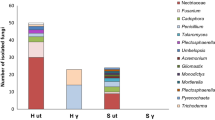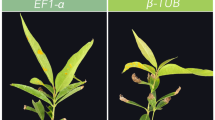Abstract
THE term ‘striate mosaic’ is proposed for a new disease of sugar cane found in the varieties Pindar and Q.57 in the Lower Burdekin district in north Queensland. The most obvious features are the short, fine striations which can just be separated by the naked eye. They are a lighter colour than the normal leaf blade and show first on the youngest exposed leaf and reach their best development as the leaf expands, but are difficult or impossible to find on mature and older leaves. They occur less in the region of the large vascular bundles than in the tissue between and so in the aggregate often give a marked striping effect on the younger leaves, or even a yellowing to the entire top. Severe stunting is usually associated with the striations but striations without obvious stunting have been found in Pindar.
This is a preview of subscription content, access via your institution
Access options
Subscribe to this journal
Receive 51 print issues and online access
$199.00 per year
only $3.90 per issue
Buy this article
- Purchase on Springer Link
- Instant access to full article PDF
Prices may be subject to local taxes which are calculated during checkout
Similar content being viewed by others
References
Hughes, C. G., and Steindl, D. R. L., Tech. Comm., No. 2, Bur. Sugar Exp. Sta. (1955).
Sein, F., J. Dept. Agric. Puerto Rico, 14, 49 (1930).
Author information
Authors and Affiliations
Rights and permissions
About this article
Cite this article
HUGHES, C. Striate Mosaic: a New Disease of Sugar Cane. Nature 190, 366–367 (1961). https://doi.org/10.1038/190366b0
Issue Date:
DOI: https://doi.org/10.1038/190366b0
Comments
By submitting a comment you agree to abide by our Terms and Community Guidelines. If you find something abusive or that does not comply with our terms or guidelines please flag it as inappropriate.



